The human race has long been intrigued by the planets of the solar system. At first, they seemed to be normal stars, but as they were studied it became clear that the brightest of stars were moving around against a background of stars that were much dimmer and fixed in place. We called them, "wanderers".
One of the most intriguing planets was not the brightest planet, but one that could change its brightness, at times proclaiming itself loudly and at other times appearing like one of the dimmer stars. It even appeared red or orange in the sky. Of course, this is the planet Mars.
After a long time, we learned that Mars was the closest planet in the solar system that humans could ever hope to inhabit because no other planet could be so easily won as the planet Mars. We learned that the journey to Mars is long, but that didn't dampen our interest. One of the first places where humans sent early probes was Mars. Of course, today many missions that Earth has launched have successfully reached the red planet and sent back lots of information. It is exciting because Mars really is the best planet in the solar system for humans to colonize. Here on this page at Astra's you will find out about the exciting missions as well as the history of Earthlings' missions to the red planet.
Navigate Astra's Guide to Mars Exploration:
Mars Orbital Explorers | Mars 2020 | Mars Rovers | Curiosity Rover | Perseverance Rover
Mars 2020
In 2020, three separate missions were launched from Earth before the October 13, 2020 Mars opposition. All three have reached the red planet safely and are doing valuable research on the Red Planet. For more information, check out Astra's Mars 2020 page
⋆ ⋆ ⋆
Early Mars Flyby Missions
Early missions were either flybys or orbiters. In the early 60's most household electronics used tubes and solid-state electronics had only been invented in 1947. The first spaceflights relied on human computers to make calculations. Some of those early electronics did not survive the 300-million mile flight to the red planet.
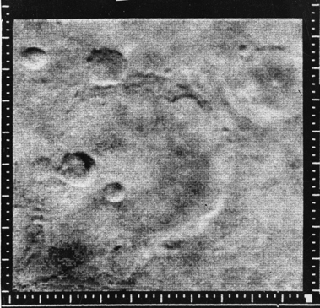
Many of the early missions sent to Mars were failures. Space hardware was new and primitive by today's standards. Mission success rates continue to improve with advanced computers and imaging equipment as technical knowledge on Earth grows by leaps and bounds.
NASA's Mariner 4 was the first successful mission that sent back pictures to Earth using a television camera, it carried the first successful digital camera into space. As it flew past the red planet on July 15, 1965, it snapped 22 images. The large crater seen here was later named after the spacecraft, "Mariner".
It took Mariner 4 one week to send the images back to Earth. NASA's engineers were too impatient to wait for computers of the day to translate the digital images, so they analyzed the data and drew their own images by hand.
Mariner Program spacecraft (US)
Mariner 4 - 1964 - flyby mission mapped 1% of Mars with 22 images and returned other data. It was the first successful probe sent to any other planet in the solar system.
Mariner 6 - 1969 - returned 50 images and data from Mars flyby. Sent with Mariner 7, it arrived first and the images it returned encouraged NASA to take more pictures of Mars' southern polar region.
Mariner 7 - 1969 - took 93 far images and 33 near images of Mars and returned data from its flyby. It also took pictures that included the larger Mars moon Phobos, making it the first spacecraft to image Phobos. Mariner 6 and 7 mapped about 20% of Mars.
Mariner 9 - 1971 - launched by US, it was the first space probe to achieved orbit. Mariner 9 went into orbit around Mars in November 14, 1971. When it arrived the entire Martian surface was totally obscured by a global dust storm - - almost no surface features were visible. The dust storm cleared in January 1972 and Mariner 9 found evidence of a planet that had many interesting geological features. Of course, there were meteor craters, but the volcanic plains were a surprise. And what volcanoes! Three huge volcanic cones beside a more massive volcano later named, "Olympus Mons". Mariner found a canyon larger than the Grand Canyon on Earth, a giant feature later named, Valles Marineris, as long as the width of the United States. There were valleys that looked as if they could be formed by water and of course, dust everywhere. Mariner 9 mapped 85% of Mars' surface and returned over 7,000 pictures. It even captured images of Mars' satellites, Phobos and Deimos.
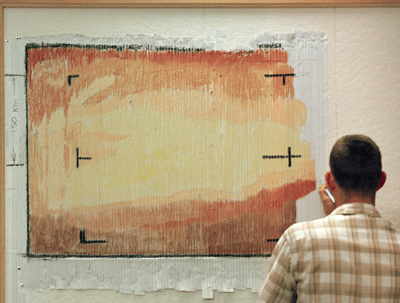
Mars program spacecraft (USSR)
Mars 2 - 1971 - orbiter made 362 orbits, sending data until August 1972. Mars 2 and Mars 3 sent back 60 pictures. Mars 2 also consisted of a lander and a rover. Unfortunately, when Mars 2 arrived at Mars, there was a global dust storm. The lander and rover could not be reprogrammed and they tried to land on Mars and crashed.
Mars 3 - 1971 - orbiter made 20 orbits, lander was successful but quit working after 110 seconds on the surface, the rover never transmitted status from Mars.
Mars 4 - 1973 - orbiter achieved a flyby in 1974 and 12 images were taken as the probe flew past Mars.
Mars 6 - 1973 - had a successful flyby but was sent with a lander that lost contact on landing.
Mars 7 - 1973 - had a successful flyby but was sent with a lander that separated too soon from the spacecraft.

Other Missions

Nozomi - Launched on July 3, 1998 - Japan's first mission to another solar system planet. It suffered a loss of propellant during one of its Earth-assist maneuvers but was able to reach Mars in 2003, when it flew by at about 1000 km. This mission carried many instruments, some that were contributions from other nations. Because of the propellant loss, it was unable to attain Mars orbit and is now in a heliocentric orbit. Nozomi was able to capture the image of Earth and the Moon shown here on July 18, 1998. Another name for Nozomi is Planet-B.
Mars Cube One - 2018 - also called MarCO was a twin flyby communication relay mission to assist the InSight mission during landing. The two small spacecraft, MarCO-A and MarCO-B, successfully provided a communications link to Earth for InSight during its entry, descent, and landing (EDL) when it was unable to contact Earth on span November 26, 2018. Although they were not sent during the early days of Mars probes, they were the first small spacecraft (or CubeSats) to operate beyond Earth orbit. Their mission to flyby the planet ended in early 2019.
Other Missions that Studied Mars while Flying By
Dawn mission sent to the main asteroid belt to investigate large asteroids Ceres and Vesta, closest approach was 549 km.
Rosetta sent by the European Space Agency to flyby comet 67P/Churyumov–Gerasimenko (67P) and the asteroids 21 Lutetia and 2867 Šteinswithin. On February 25 2007, Rosetta passed a mere 250 kilometers (160 mi) away from Mars. Because the solar panels could not be used when the craft was in the planet's shadow 15 minutes, it would experience shortage of power. Rosetta was unable communicate with Earth and had to fly on batteries. Because this was a risky maneuver, it was dubbed, "The Billion Euro Gamble". The flyby was successful and Rosetta returned detailed images of the surface and atmosphere of Mars and then continued to its next destination: another flyby of planet Earth.
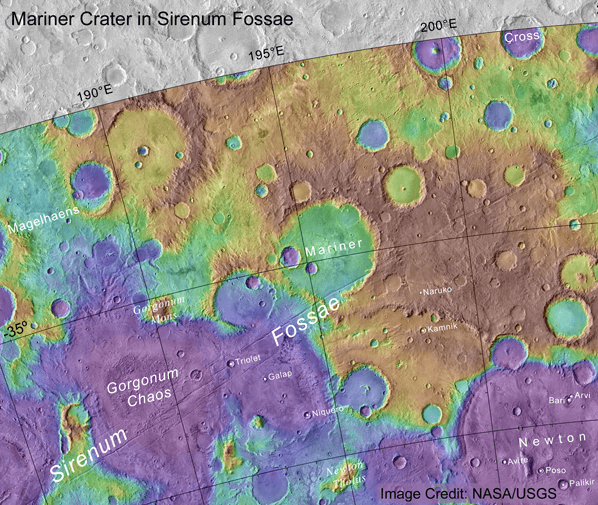
This false color image was slightly edited from the NASA/USGS map to show off Mariner crater, the crater that was named after the Mariner 4 mission that sent back an image of the area as it passed Mars.
Compare this recent image to the image above that is a facsimile of the image sent back by Mariner4's television camera. Note the position of the various smaller craters in comparison and you will see that this is an image of the same crater that was captured by the first successful mission sent to Mars.
⋆ ⋆ ⋆
Mars Landers
This page contains in-depth information on Mars Landers - - that means stationary platforms. Orbiters and Rovers are covered in depth on additional pages at Astra's.
NASA's Viking Project was the first U.S. mission to send spacecraft to Mars and land safely on the surface. It was the first mission to Mars to return images of the surface. The Mars Vikings were two identical spacecraft, each consisting of both a lander and an orbiter. The orbiter and the lander flew together and successfully entered Mars orbit. The landers then separated and descended to the planet's surface.
NASA Mars Viking Project
Viking 1
Launch Date: August 20, 1975
Mars Orbital Insertion: June 19, 1976
Mars Landing: July 20, 1976
Landing Site: Chryse Planitia
Orbiter Mission End: August 17, 1980
Lander Mission End" November 13, 1982
The Mars Viking 1 lander operated on Mars 2,245 sols (Mars days) setting an endurance record (more than 6 years) that was not broken until the Opportunity Rover mission ended in 2010. Viking 1 landed on the western slope of Chryse Planitia (the Plains of Gold) at 22.3 deg. N. latitude, 48.0 deg. longitude.
When the spacecraft arrived at Mars and the orbiter began imaging the surface, it was found that the landing area in Chryse Planitia was far to rocky to land the Viking. Although the landing was planned to be on July 4, 1997 to celebrate the bicentennial of the United States of America, the lander could not be deployed until July 20. Coincidentally, this was 20th anniversary of the first touchdown by US citizens on the surface of the Moon during Apollo 11.
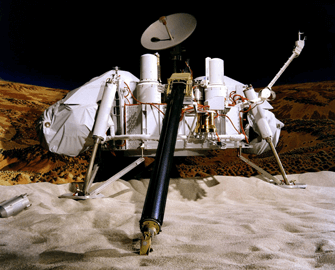
Both spacecraft were launched from Cape Canaveral, FL. Both landers were sterilized before launch to prevent contamination of Mars with organisms from Earth. The spacecraft spent nearly a year cruising to Mars. The Viking mission was planned to last for 90 days after landing. Each orbiter and lander operated far beyond its expected design lifetime. The Viking project's primary mission ended on November 15, 1976, 11 days before Mars’ superior conjunction when Mars passed behind the Sun for Earth-based observers. In December 1976, shortly after Mars emerged from conjunction, mission controllers reestablished the connection with the Mars probes, and began extended-mission operations. Viking 1 Lander lasted the longest, finally ending its mission in November 1982.
Viking 2
Launch Date:September 9, 1975
Mars Orbital Insertion: August 7, 1976
Mars Landing: September 3, 1976
Landing Site: Utopia Planitia
Orbiter Mission End: July 25, 1978
Lander Mission End: April 11, 1980
Viking 2 touched down at Utopia Planitia, at 47.7 deg. N. latitude and 48.0 deg. longitude. The Viking landers' spacecraft consisted of five basic systems: the lander body, the bioshield cap and base, the aeroshell, the base cover and parachute system and lander subsystems. The completely outfitted lander measured approximately 3 meters (10 feet) across and was about 7 ft. (2 m) tall. It weighed about 1,270 lbs. (576 kg) without fuel on Earth. The lander body was a basic platform for science instruments and subsystems. It was supported by three landing legs, 51 in. (1.3 m) long each attached to a circular footpad 12 in. (30.5 cm) in diameter. The two-piece bioshield was a pressurized cocoon that completely sealed the lander from a biological contamination until leaving Earth. Viking 1 and 2 landers were powered by radioisotope thermoelectric generators or RTG's and had no solar panels.
The results from the Vikings provided the best view of Mars of the day. Orbiter images showed volcanoes, lava plains, immense canyons, cratered areas, wind-formed features, and evidence of surface water. Mars appeared to be divisible into two main regions, northern low plains and southern cratered highlands. The Tharsis and Elysium volcanic areas bulge out from the surface. Lastly, the Valles Marineris, a system of giant canyons near the equator, perhaps mute testimony to the violent activity in the Tharsis area. The surface material at both landing sites is iron-rich clay. Temperatures on Mars averages about -81 deg. F with temperature ranges from around -220 deg. F. during winter at the poles, to +70 deg. F. Seasonal dust storms, pressure changes, and transport of atmospheric gases between the polar caps were observed.
Instruments on Viking
Lander
Imaging System (2 facsimile cameras)
Gas Chromatograph Mass Spectrometer (GCMS)
Seismometer
The seismometer on Viking 1 did not work but Viking 2 returned data throughout its active life on the planet. Most of the activity it found was attributed to wind.
X-Ray Fluorescence Spectrometer
Biological Laboratory
Viking landers conducted three biology experiments designed to look for possible signs of life. These experiments discovered chemical activity in the soil, but the results showed no clear evidence of living microorganisms in soil near the landing sites.
Weather Instrument Package (Temperature, Pressure, Wind Velocity)
Remote Sampler Arm
Each lander was equipped with a 3m-long Robotic Arm (RA) used to acquire Mars' top soil. The soil would be sieved and delivered to instruments on the lander such as the GCMS.
Orbiter
Imaging System (2 vidicon Cameras)(VIS)
Infrared Spectrometer for Water Vapor Mapping (MAWD)
Infrared Radiometer for Thermal Mapping (IRTM)
Aeroshell
The aeroshell protected the landers during descent to the surface. Its ablative heat shield kept the landers from burning up in the atmosphere and provided a parachute to make Mars landing a soft landing on the surface. Instruments on the aeroshell include:
Retarding Potential Analyzer
Upper-Atmosphere Mass Spectrometer
Pressure, Temperature, and Density Sensors
"In total, the two Viking orbiters returned 52,663 images of Mars and mapped about 97 percent of the surface at a resolution of 984 feet (300 meters) resolution. The landers returned 4,500 photos of the two landing sites." - NASA Solar System Exploration Viking 1
- NASA Solar System Exploration Viking 1
It was irresistible, I couldn't resist the urge to embed this video from NASA recorded for the 40th anniversary of the Viking Missions in 2016. The video captures the spirit and the era with images from the past. Mars exploration continues, boldly and intently in this millennium.
- - Astra
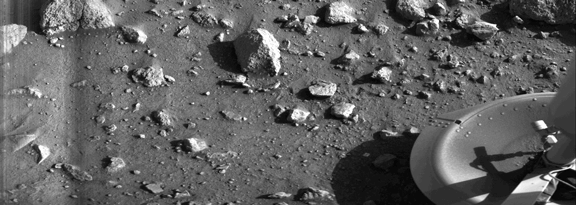
- - Find out about Viking Orbiter on Astra's Mars Orbital Explorers page

Mars Pathfinder Lander
Launch Date: December 4, 1996
Mars Landing: July 4, 1997
Landing Site: Chryse Planitia
End of Mission: September 27, 1997
Okay the small pathfinder rover, Sojourner won the hearts of the American public, but the real brains behind Sojourner was the sophisticated lander that really was the star of the Pathfinder Mission. The entire mission was a technology demonstration that was a small version of a concept that might become a future technology if it was successful. Sojourner pathfinder paved the way for the next generations of rovers. There's more information about Sojourner on this page in the rover section.
But what about that lander?
Mars Pathfinder was launched in December 1996 and landed on Mars' Ares Vallis on July 4, 1997. It demonstrated a new way to deliver an instrumented lander and the first-ever robotic rover to the surface of the red planet. Mars Pathfinder innovated method of entering the Martian atmosphere, using a parachute to slow its descent through the atmosphere and giant airbags to cushion the impact as it landed on the surface. The lander was renamed the Carl Sagan Memorial Station, in honor of the astronomer who died while Pathfinder was on its way to Mars.
The lander carried instruments for scientific observations and to provide engineering data on the new technologies being demonstrated. It carried scientific instruments to analyze the Martian atmosphere, climate, geology and the composition of its rocks and soil. The lander had a stereoscopic camera with filters mounted on an expandable pole called, Imager for Mars Pathfinder (IMP). It sent back more than 16,500 pictures.
Among Pathfinders' discoveries were rounded pebbles at the landing site suggesting that there was running water on Mars in the past. It showed the airborne dust on Mars is magnetic, possibly because it contains by maghemite, a very magnetic form of iron oxide. Dust devils were detected and measured by temperature, wind and pressure sensors. Early morning water ice clouds were seen in the lower atmosphere.
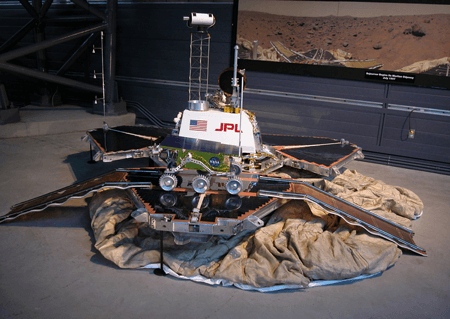
This engineering model is on display at the Smithsonian, the image was used merely for educational purposes and credit must be given to NASA, JPL and the Smithsonian where the object is on display at Space Science at the Steven F. Udvar-Hazy Center in Chantilly, VA. The exhibit shows the Pathfinder mission as if it has just landed on the surface of Mars. Sojourner has been activated and is ready to roll off the lander and on to the surface of Mars.
- - Find out more about the Pathfinder Engineering Model at the Smithsonian Air and Space Museum.

Mars Phoenix
Launch Date: August 4, 2007
Mars Landing: May 25, 2008
Landing Site: Vastitas Borealis
End of Mission: November 2, 2008
Mars Phoenix was the first NASA mission to Mars led by a university, the University of Arizona's Lunar and Planetary Laboratory with project management by NASA's Jet Propulsion Laboratory.
- Like the Phoenix Bird Rising from the Ashes -
Phoenix Lander was reborn from fire! NASA was still reeling from the loss of Mars Climate Orbiter and Mars Polar Lander that failed spectacularly about 40 meters from the Mars surface. The NASA's Mars Surveyor Program was canceled. It was the age of faster, better, cheaper missions and the agency was focused on sending a mission to Mars during every opposition. Because Mars is at its closest only once every 2 years, this is a basic imperative for a good Mars exploration program. (At least as far as I am concerned - Astra)

Phoenix Mars Mission was created from re-structured instruments and some equipment from the previous Mars endeavors. Phoenix used spacecraft and equipment built for the Mars Surveyor Program. Lessons learned from the failures meant the mission engineering team began working on improving spacecraft reliability through extensive testing. Mars mission failures are not the subject of the Guide to Mars Exploration but may someday find a place here at Astra's Stargate.
Phoenix landed safely on Mars at Vastitas Borealis in a place engineers dubbed, the "Green Valley". When Phoenix was sent to Mars, there were three spacecraft orbiting Mars: Mars Reconnaissance Orbiter (MRO), Mars Odyssey and ESA's Mars Express. The orbiters took pictures as Phoenix landed on May 25, 2008.
Instruments
The Atmospheric Structure Experiment was conducted during the lander's descent through the atmosphere. Accelerometer and gyroscope data was recorded to create a profile of the temperature, pressure, and density of the atmosphere above the landing site.
The Surface Stereo Imager (SSI)
SSI was a stereo camera that had higher resolution than the imagers used for Mars Pathfinder and Mars Polar Lander.
Thermal and Evolved Gas Analyzer (TEGA)
TEGA was a combination of a high-temperature furnace with a mass spectrometer.
The Mars Descent Imager (MARDI)
MARDI was to take pictures of the landing site during the last three minutes of descent. A flaw was found before launch that may have jeopardized the mission, so the camera was not used on the mission.
The Meteorological Station (MET)
MET recorded the weather on Mars during the course of the Phoenix mission. It had a wind indicator and pressure and temperature sensors. The MET also contained a LIDAR (light detection and ranging) device to sample the number of dust particles in the air.
The Microscopy, Electrochemistry, and Conductivity Analyzer (MECA)
MECA is an instrument package originally designed for the canceled Mars Surveyor 2001 Lander mission and was built by the Jet Propulsion Laboratory. It consisted of various instruments:
Wet Chemistry Laboratory (WCL)
Soil scooped up by the robotic arm was placed into one of four cells, water was added and it was stirred. Electrochemical sensors measured the ions such as sodium, magnesium, calcium, and sulfate that leached out into the water.
Thermal and Electrical Conductivity Probe (TECP)
TECP had four probes to measure: Martian soil temperature, relative humidity, thermal conductivity, electrical conductivity, dielectric permittivity, wind speed, and atmospheric temperature.
Optical microscope
The optical microscope, designed by the University of Arizona, is capable of making images of the Martian regolith, the field of view of the microscope is 2 mm × 2 mm.
Atomic force microscope
The atomic force microscope could scan a small area of the sample delivered to the optical microscope. The maximum resolution of the instrument was 0.1 micrometers. University of Neuchatel
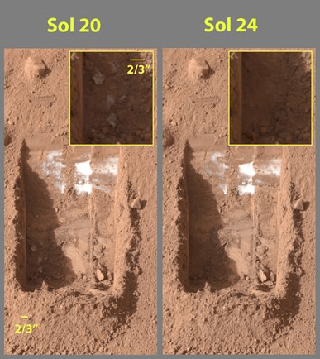
These color images were taken by NASA's Phoenix Mars Lander's SSI on the 21st and 25th days of the mission, or Sols 20 and 24 (June 15 and 19, 2008). The trench informally called "Dodo-Goldilocks"; was dug by the lander, using its robotic arm. On Sol 20, the freshly dug hole clearly showed the white ice below the surface. But Mars dry atmosphere proves to cause the ice to sublimate almost immediately. In the lower left corner of the left image, a group of lumps is visible. The area has been magnified in the inset images. Over the course of four days on Sol 24 the lumps have disappeared. The sublimation process is similar to the process of evaporation.

Interior Exploration using Seismic Investigations, Geodesy and Heat Transport (InSight)
Launch Date: May 15, 2018
Mars Landing: November 26, 2018
Landing Site: Elysium Planitia
End of Mission: December 15, 2022
Mars Insight may hold the distinction of having the longest name of Mars landers. As a Mars explorer goes, it has faced some challenges. InSight inherited technological and science improvements from the lessons learned from the Phoenix spacecraft. It was delayed for its 2016 launch by problems with the seismometer (SEIS described below) that increased the mission cost $150 million dollars. It was launched in 2018 and successfully landed on Elysium Planitia. This area was probably repaved by flows from the nearby volcanoes, the largest called, Elysium Mons rising 41,000 ft. (12.6 km) above its base, making it the third tallest volcano on Mars.
Mars Insight was accompanied to Mars by the Mars communication relay satellites MarCO-A and B. they were named "EVE" and "WALL-E". They carried their own communications and navigation experiments and flew independently to Mars. The MarCO satellites had a "CubeSat" design. CubeSats are a type of spacecraft based on a standardized small size and commercially available technologies. They were sent to Mars as a technology demonstration and they represent the first deep space use of CubeSats. They monitored the InSight spacecraft during landing.
Mars Insight conducted its mission until its panel solar panels became so dusty it was having trouble recharging. In an effort to remove some of the dust from the panels the Insight science team instructed the scoop on the robotic arm to pick up some soil and trickle it near the solar panels during the windiest time of the Martian day, hoping that grains would be hop off the panel and be removed by the Martian wind. On May 22, 2021, the attempt was made and Insight did gain some power.
After the panels were cleared, Insight detected interesting events on Mars. On December 24, 2021, Insight detected an impact that was later discovered to cause craters that were later imaged by NASA’s Mars Reconnaissance Orbiter. Insight recorded the largest quake ever detected on another planet occurring in the Cerberus Fossae region of Mars. Estimated at magnitude 5, the quake occurred on May 4, 2022. NASA lost communications with the InSight lander on December 15, 2022, with the end of the mission being declared on December 21, 2022.
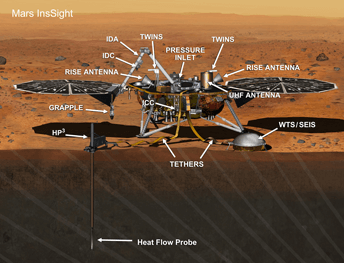
Instruments
Instrument Deployment Arm (IDA)
IDA is used to place the lander's sensitive instruments on the ground. The instruments can obtain their best measurements in direct contact with the Martian surface. IDA is 5 ft. 9 in. (1.8 m) long. It has shoulder, elbow, and wrist joints and there is a grapple is at the end of the arm. A camera is mounted between the elbow and wrist. Four motors allow the arm to move.
IDA's camera has a 45-degree field of view and can take full color images of the terrain surrounding the landing site determine the best place to set the instruments on the surface. The camera can be pointed in any direction and can take images that can be combined into a 360-degree panoramic view of its surroundings.
Seismic Experiment for Interior Structure (SEIS)
SEIS is a seismometer that measures the vibrations caused by the internal activity of Mars. It is a round, dome-shaped instrument that sits on the Martian surface and measures seismic vibrations of Mars from marsquakes or thumps of meteorite impacts. SEIS may provide a glimpse into the planet’s internal activity helping to understand properties of the crust, mantle and core. It has sensors to measure wind, pressure, temperature, and magnetic fields.
Heat Flow and Physical Properties Package (HP3)
HP3 was designed to burrow 16 ft. (5m) below the Martian surface, it includes a tether that is equipped with embedded heat sensors to study the thermal properties of Mars' interior. It measures the heat coming from Mars' interior to reveal how much heat is flowing out of the body of the planet and what the source of the heat is. This is an attempt to determine whether Mars formed from the same stuff as Earth and the Moon. Unfortunately, this instrument never succeeded at digging and placing the heat sensors. There were many attempts to remedy the problem but in January 2021 it was decided that the soil would never provide enough friction for the drill to work.
Seismic Experiment for Interior Structure (RISE)
A radio science instrument, RISE, measures the wobble of Mars' North Pole as the sun pushes and pulls it in its orbit, providing clues on the size and composition of Mars' metallic core.
⋆ ⋆ ⋆
Mars Orbital Explorers
This is an overview of the spacecraft that study Mars from orbit. For in-depth information use the Mars Orbital Explorers page at Astra's
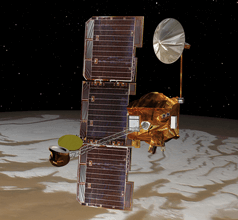
Mars Odyssey
Entering Mars orbit in October 2001, Mars Odyssey holds the record for the longest active spacecraft in orbit around a planet other than Earth, over two decades!
Mars Express
Mars Express orbiter was launched by the European Space Agency (ESA) on June 3, 2003. Mars Express was sent to Mars with a rover, named Beagle 2. Beagle 2 was to land in Isidis Planitia but it did not survive the landing. Mars Express has been used for many years to send images and data back to Earth.
Mars Reconnaissance Orbiter (MRO)
MRO entered Mars orbit on March 10, 2006. It came to Mars with High Resolution Imaging Science Experiment (HiRISE), the largest reflector ever carried on a deep space mission (20 inches or 0.5 meters.)
Mars Atmosphere and Volatile Evolution (MAVEN)
Entering Mars orbit on September 22, 2014, MAVEN observed the comet "Siding Spring" (C/2013 A1) as it passed Mars in October 2014.
Mars Orbiter Mission (ISRO)
The Mars Orbiter Mission is the Indian Space Research Organisation (ISRO) first attempt at an interplanetary mission. It has been orbiting and returning valuable data and images of Mars since September 24, 2014. The name of the orbiter is, "Mangalyaan" meaning "Mars Craft".
ExoMars Trace Gas Orbiter (TGO)
ExoMars Trace Gas Orbiter was built by the European Space Agency (ESA) and Roscosmos. It arrived at Mars on October 19, 2016. TGO was the designed to search for trace gases in the Martian atmosphere such as methane, water vapor, nitrogen oxides and acetylene. ExoMars monitors seasonal changes in the Martian atmosphere and will look for water-ice beneath the surface. Data sent back from the mission will help ESA decide landing sites for future ESA missions. In addition to the orbiter, Schiaparelli lander was primarily a technology demonstration vehicle. Unfortunately, it did not survive the landing at Mars.
UAE Al-Amal or Hope
Arriving at Mars in February 2021, Al-Amal is the United Arab Emirates (UAE) first mission attempt at any other solar system planet. Hope probe has released its fourth data set, and it has been made available.
Tianwen 1 orbiter
The first mission to Mars ever attempted by the China National Space Administration (CNSA), Tianwen 1 successfully reached Mars on February 10, 2021. China officially concluded its Tianwen-1 Mars mission on August 3, 2022. Tianwen-1 completed 1,344 orbits mapping the planet’s entire surface of Mars.
⋆ ⋆ ⋆
Mars Rovers Exploring the Surface
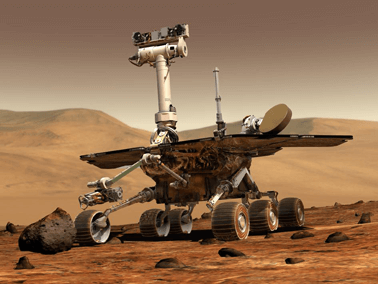
Because Mars is so far away and the surface will not support life, robotic explorers or rovers have been sent to study the surface of Mars as well as the Moon. Rovers can study more territory then stationary landers. They can be instructed from Earth to investigate further into the interesting areas that they encounter on their journey. Each rover sent and successfully deployed can advance the knowledge of building robots to perform remote activities. Mars rovers serve a different purpose than orbital spacecraft. Orbiters have the advantage of being able to use their solar arrays constantly from space but rovers can dig in the dirt and investigate Mars up close.
Successful Mars Rover Missions
There have been 6 successful rover missions on Mars, all but one was sent by NASA for the United States of America until 2021, when the China National Space Agency (CNSA) successful sent their first Mars rover, Zhurong. NASA rovers began small, in the form of microwave-oven sized Sojourner, but quickly gained in complexity.
Until our space exploration technology grows beyond today's modest capabilities, Mars must be studied by remote rovers. More data will come back from the rovers that are exploring Mars as of this writing, Perseverance, Zhurong, and Curiosity. The rovers are joined at Mars by a host of orbiting satellites that keep a close "eye" on their roving counterparts.

Mars Pathfinder Rover
Launch Date: December 4, 1996
Mars Landing: July 4, 1997
Landing Site: Chryse Planitia
End of Mission: September 27, 1997
NASA's Sojourner is the first robotic Mars rover. It landed in the Ares Vallis channel in Chryse Planitia on Mars. Sojourner was operational on Mars for 92 sols (95 Earth days). It was the first wheeled vehicle to rove on a planet other than Earth.
Sojourner arrived at Mars with the Pathfinder lander, later called, Carl Sagan Memorial Station. The mission landed on Mars using a parachute and giant airbags, finally bouncing to a stop at 19.30 deg N latitude and 33.52 W. longitude in Ares Vallis.
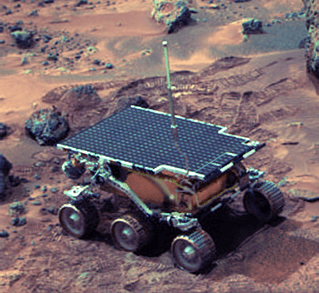
Mars Pathfinder was a very successful mission. Landing on Mars after some huge failures by NASA and the Soviet Union, the mission won the hearts of the people on Earth. It was largely due to the access that the internet could provide to capture the excitement of the event of a robotic landing.

Mars Exploration Rovers (MER)
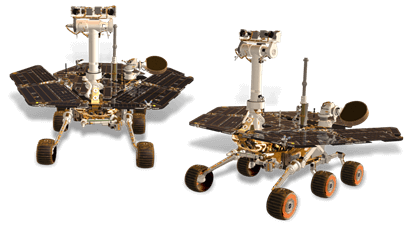
The twin rovers sent on the Mars Exploration Mission are Spirit and Opportunity. The primary surface mission for MER rovers was planned to last at least 90 sols (Martian days). Spirit operated for 6 years and Opportunity for a record 15 years! (That's Earth years.)
Because of the massive amount of information returned from Mars by both rovers, two asteroids were named in their honor: 37452 Spirit and 39382 Opportunity.
Spirit also known as MER-A (Mars Exploration Rover – A) or MER-2
Launch Date: June 10, 2003
Mars Landing: January 4, 2004
Landing Site: Gusev Crater
End of Mission: March 22, 2010
Spirit was the first rover to be constructed for the Mars Exploration Mission and so was the one that gave engineers the most issues to deal with. After Spirit's systems were worked out, its twin Opportunity had the benefit of the engineer's experience. Spirit Rover traveled 4.8 miles or 7.7 km exploring Gusev crater on Mars.
Opportunity also known as MER-B (Mars Exploration Rover – B) or MER-1
Launch Date: July 8, 2012
Mars Landing: January 25, 2004
Landing Site: Meridiani Planum
End of Mission: June 10, 2018
Opportunity rover also had the nickname, Oppy. As its twin Spirit, struggled with its barren landing area on Gusev crater, Opportunity landed in a fantastic spot to explore Mars. Within the first month, Opportunity rover spotted round, iron-rich concretions that were nicknamed "blueberries". Opportunity traveled Meridiani Planum for 14 years and 46 days (in Earth time). Its last contact with NASA came on June 10, 2018, after the rover had traveled a distance of 28 miles or 45 km.

Mars Science Laboratory (MSL)
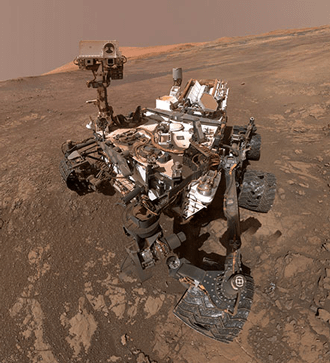
Launch Date: November 26, 2011
Mars Landing: August 6, 2012
Landing Site: Gale Crater
End of Mission: Ongoing
Curiosity Rover is the first rover that used nuclear fuel for power. It is powered by a radioisotope thermoelectricgenerator or RTG, making it unnecessary for the rover to have solar panels. It was the largest rover ever--weighing about 900 kg on Earth. The total launch weight of the MSL mission was 8,463 lbs. or 3,839 kg, launching on a Atlas V 541 vehicle.
Curiosity has a 6 ft. 11 in. or 2.1 m long robotic arm that holds five devices that can spin through a 350° turning range. Two of the five devices contact the surface they study: the X-ray spectrometer (APXS), and the Mars Hand Lens Imager (MAHLI). The MAHLI camera is one of 17 cameras, the others are: 8 HazCams, 4 NavCams, 2 MastCams, the MARDI, and the ChemCam.
The MAHLI camera is versatile, with its macro lens it can take images at distances between ~22.5 mm and infinity. This is the instrument that takes "selfies" of Curiosity on Mars. The images of Curiosity rover are taken with the MAHLI camera on the rover's arm, then they are analyzed back at Earth. Many images contain the arm of course, but those pieces of the image are subtracted from the final product. Curiosity can send back thumbnails of images from MAHLI so that scientists can select best images to transmit to Earth, thereby saving bandwidth.
- - Find out more about Curiosity on the Curiosity Rover page at Astra's.

Mars 2020
Perseverance Rover - NASA's latest successful rover
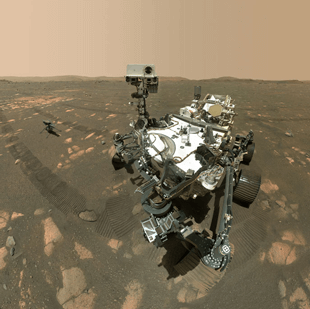
Launch Date: July 30, 2020
Mars Landing: February 18, 2021
Landing Site: Jezero Crater
End of Mission: Ongoing
Perseverance is studying Jezero Crater on a search to find signs of life. Billions of years ago, the crater basin was a lake that was being supplied by a river. The river was forming a delta and the result of that process can still be seen today. The rock and soil samples that Perseverance collects at Jezero could help answer questions about the existence of life beyond Earth.
The Perseverance rover is only the beginning. NASA and the European Space Agency (ESA) are planning future missions that will bring the rover's samples back to Earth for in-depth study by scientists. The equipment on Earth is too sophisticated and complex for a rover to carry to Mars, so the samples will be coming back home. As Perseverance collects samples, it leaves them in various places where they can be retrieved later.
The mission involves sending more than one spacecraft, including two additional rovers to collect the samples, an orbiter to facilitate communications and grab the returned samples when they are lifted from the surface by a special vehicle that is known as a Mars Ascent Vehicle or MAV. Being able to return samples (or launch astronauts for that matter) from the deep gravity well of Mars is essential to future space exploration.
- - Find out more about Perseverance and the sample return mission on the Perseverance Rover page at Astra's.

Zhurong - the first Chinese rover to land on Mars
Launch Date: July 23, 2020
Launch Site: Wenchang Spacecraft Launch Site
Mars Landing: May 22, 2021
Landing Site: Utopia Planitia
End of Mission: Ongoing
China's Tianwen-1 mission reached the red planet and successfully inserted into Mars orbit on February 10, 2021. This mission consists of an orbiter, a lander, and a robot. They became the sixth space agency to orbit a spacecraft at Mars, and only the second to successfully land and deploy a rover.
The rover is equipped with Ground-Penetrating Radar (GPR), the Mars Surface Magnetic Field Detector (MSMFD) the Mars Meteorological Measurement Instrument (MMMI), and the Mars Surface Compound Detector (MSCD), a spectrometer. The rover also has two cameras: the Multi-Spectrum Camera (MSC) and the Navigation and Topography Camera (NTC).
The Zhurong rover is currently in shutdown mode and is expected to continue its exploration of Mars in December 2022. The primary mission of Tianwen-1 has been successfully completed. The orbiter will continue to take images and gather data on Mars.
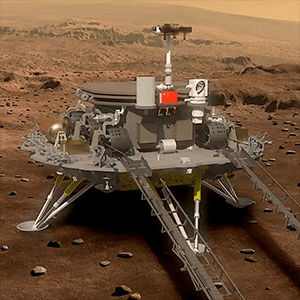
- - Find out more about Tianwen-1 and Zhurong on the Mars Exploration 2020 page at Astra's.

(Plaque on 2020 Rover Perseverance)
- Read more about Curiosity Rover - and - Perseverance Rover at Astra's
Future Mars Missions
Martian Moons eXploration mission
Tentative Launch Date: 2026
Martian Moons eXploration mission (MMX)is an exciting mission from the Japan Aerospace Exploration Agency (JAXA) is sources of methane (CH4) and other trace gases present in the Martian atmosphere that could be evidence biological or geological activity. The TGO was intended to act as a communications relay satellite, but the Schiaparelli lander crashed before reaching the surface.
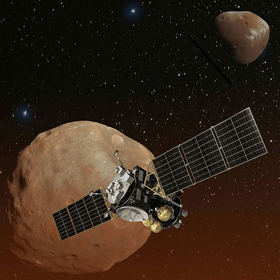
Instruments
TElescopic Nadir imager for GeOmOrphology (TENGOO)
TENGOO is a narrow field camera for detailed terrain study.
Optical RadiOmeter composed of CHromatic Imagers (OROCHI)
The gamma-ray spectrometer searches for elements on or near the Martian surface. It can detect the presence of 20 chemical elements, including hydrogen carbon, silicon, iron and magnesium.
Light Detection and Ranging (LIDAR)
LIDAR uses a laser to reflect light from the moon's surface, to study surface altitude and albedo.
Mars-moon Exploration with GAmma rays and NEutrons (MEGANE)
MEGANE is a gamma-ray and neutron spectrometer developed in partnership with NASA.
MIRS - MMX InfraRed Spectrometer
A near-infrared observation device for characterizing the minerals that make up the moons of Mars.
Circum-Martian Dust Monitor (CMDM)
CMDM is a dust counting device for characterizing the environment around the Martian moons,
Mass Spectrum AnalyzerMass Spectrum Analyzer (MSA)
Mass Spectrum Analyzer, an instrument to study the ion environment around Mars.
Watch JAXA's Martian Moons eXploration mission movie from the official JAXA YouTube channel.
Mars Orbiter Mission - 2 (MOM-2)
Tentative Launch Date: 2025
Mangalyaan-2 or MOM-2 is thought to be the next Mars mission to be flown by Indian Space Research Organisation (ISRO). The first Mangalyaan mission was launched on November 5, 2013. The spacecraft successfully reached Mars insertion on September 24, 2014. I operated successfully until October 2, 2022, when it lost communications with Earth.

Escape and Plasma Acceleration and Dynamics Explorers (EscaPADE)
Tentative Launch Date: No earlier than November 9, 2025
NASA's EscaPADE consists of dual Mars orbiters. These two identical interplanetary Photon spacecraft were developed by Rocket Lab. Both spacecraft are about the size of a mini-fridge and weigh no more than about 250 pounds (120 kilograms) excluding fuel. This mission is part of NASA's Small Innovative Missions for Planetary Exploration (SIMPLEx). The total cost for these spacecraft is expected to be less than $80 million. EscaPADE is led by the UC Berkeley Space Sciences Laboratory. More information can be found on their EscaPADE page. Other partners include NASA's Goddard Space Flight Center, Embry-Riddle Aeronautical University, Advanced Space LLC, and Blue Origin. Launching from LC-36, NG-2 at Kennedy Space Center.
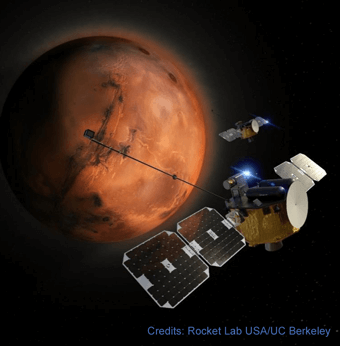
The EscaPADE orbiters will study how Mars’ magnetosphere (magnetic area of space around the planet) interacts with the solar wind, and the processes driving its atmospheric escape. Orbiting two satellites at Mars will allow simultaneous two-point observations making the first "stereo" picture of this Martian environment. The mission is expected to last one year. Understanding the magnetosphere at Mars is important because it is very different from Earth's protective magnetic shield. Understanding the differences may help us to understand how Mars lost its water.
EscaPADE was to be launched with the Psyche Mission in July of 2022, but that mission was delayed and EscaPADE's launch had to be postponed until fall 2025, the next time Earth and Mars are at opposition.
These satellites are being called "Blue" and "Gold". Each carries three scientific instruments onboard.
Instruments
EMAG
EMAG is a magnetometer that will measure DC magnetic fields and is mounted on the boom
EESA
EESA is an electrostatic analyzer designed to measure ions, mounted on the upper deck of the spacecraft. It has two related instruments, EESA-i studying ions and EESA-e studying electrons.
ELP
ELP is a Langmuir probe measuring plasma density and is mounted on the boom of the spacecraft.
- - Find out more about the EscaPADE mission on NASA's EscaPADE page.
Tianwen-3 Mars Sample Return mission
Planned Launched: 2028
Launch Site: Wenchang Spacecraft Launch Site
China's CSNA Tianwen-3 mission is a Mars Sample return mission. The plan is to return smaples from the Martian surface using a two-part plan. The spacecraft will carry two separate components--a lander that will collect samples on the Martian surface and an orbiter, that will orbit Mars and receive the samples and carry them back to Earth.
A landing site has not yet been chosen. The site to be chosen will have to be safe for landing and considered exceptional for scientific study. It will be one that could support life and have an environment that could actually preserve that life. The lander will drill two meters underground, below the depth that radiation hitting Mars' surface can destroy organic materials. It is hoped that Tianwen-3 will find signs of past or present life preserved after billions of years.

Rosalind Franklin Rover
Planned Launched: unknown
The Trace Gas Orbiter mission was successful launched and is in orbit around Mars. The TGO spacecraft carried the Entry, Descent and landing demonstrator Module (EDM), called Schiaparelli rode on TGO from Earth to Mars. Unfortunately the lander crashed on Mars on October 19, 2016 when its parachute was deployed too early. Schiaparelli EDM was a test mission. The second phase of the TGO includes a lander and a rover. This mission was a joint mission between Roscosmos and ESA.
Scheduled to launch for the 2022-23 opposition of Mars, the mission has met with a setback due to Russian attack on the Ukraine. It is unknown when or if the ExoMars mission will continue.
The future mission's lander, Kazachok, is named after a Russian folk dance. The Rosalind Franklin rover is named after the British scientist who helped discover the structure of DNA. Rosalind Franklin will be Europe's first Mars rover. It is designed to detect signatures of life on the red planet.
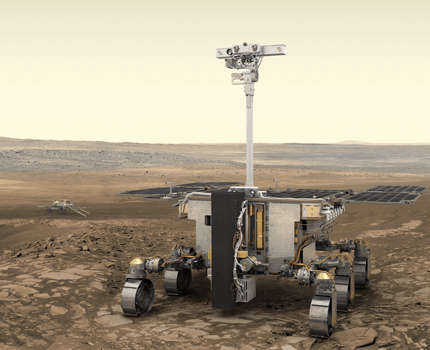
Navigate Astra's Guide to Mars Exploration:
3 Faces of Mars Home | Mars Orbital Explorers | Mars 2020 | Mars Rovers | Curiosity Rover | Perseverance Rover
This webpage is ©2025 D. E. Jenkins all rights reserved. Please use the contact page to get permission to use this content or to send comments or corrections.
Last Modified: 11/06/2025
